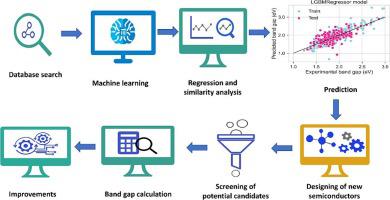当前位置:
X-MOL 学术
›
Comp. Mater. Sci.
›
论文详情
Our official English website, www.x-mol.net, welcomes your feedback! (Note: you will need to create a separate account there.)
Machine learning assisted prediction of band gaps and designing of new polymers for photodetectors: A complete pipeline
Computational Materials Science ( IF 3.3 ) Pub Date : 2024-03-21 , DOI: 10.1016/j.commatsci.2024.112961 Fatimah Mohammed A. Alzahrani , Muhammad Sagir , Muhammad Saqib , Shahida Bashir , Tayyaba Sarwar , Shabbir Hussain , Shahzad Murtaza , Afifa Mushtaq , Rafia Razzaq , Z.A. Alrowaili , M.S. Al-Buriahi
Computational Materials Science ( IF 3.3 ) Pub Date : 2024-03-21 , DOI: 10.1016/j.commatsci.2024.112961 Fatimah Mohammed A. Alzahrani , Muhammad Sagir , Muhammad Saqib , Shahida Bashir , Tayyaba Sarwar , Shabbir Hussain , Shahzad Murtaza , Afifa Mushtaq , Rafia Razzaq , Z.A. Alrowaili , M.S. Al-Buriahi

|
The band gap is a crucial parameter of photovoltaic materials, which primarily affects their applicability and performance. Therefore, predicting band gaps of targeted materials accurately and rapidly is of utmost importance for designing photodetectors. In comparison to computationally costly first-principles calculations, machine-learned models can enable accurate, rapid, and low-cost predictions of the bandgaps. In this study, we employ machine-learning tools for the accurate and fast prediction of band gaps of polymers for photodetectors. Importantly, about fifteen (15) regression models are developed and tested to screen the models with highest predictive capability. The best models for targeted predictions among others are the light gradient boosting and hist gradient boosting models. Moreover, similarity analysis is applied to screen/search potential materials for photodetectors with high performance using reference building blocks. Gasteiger atomic charges of reference building blocks are also computed. Harvard organic photovoltaic database is explored to screen new building blocks/ monomers using their Tanimoto index. Both Breaking Retro Synthetically Interesting Chemical Substructures (BRICS) method and human controlled monomer designing methods are used to design monomers using previously searched buildings blocks automatically and manually, respectively. The band gaps of selected organic semiconductors are predicted. In addition, clustering of compounds and heatmaps of selected compounds is constructed. The synthetic accessibility score shows that BRICS-based automatic monomer designing shows negative score (i.e., difficult to synthesize), while human controlled/manual monomer designing shows positive score (i.e., easy to synthesize). Our methodology has immense potential in screening polymers with targeted bandgaps prior to experimental synthesis that could accelerate the designing of new polymers for photodetector and other photovoltaic applications.
中文翻译:

机器学习辅助预测带隙和设计用于光电探测器的新型聚合物:完整的流程
带隙是光伏材料的一个重要参数,主要影响其适用性和性能。因此,准确、快速地预测目标材料的带隙对于设计光电探测器至关重要。与计算成本高昂的第一性原理计算相比,机器学习模型可以实现准确、快速且低成本的带隙预测。在这项研究中,我们采用机器学习工具来准确快速地预测光电探测器聚合物的带隙。重要的是,开发并测试了大约十五 (15) 个回归模型,以筛选具有最高预测能力的模型。其中,用于目标预测的最佳模型是光梯度增强模型和直方图梯度增强模型。此外,相似性分析用于使用参考构建块筛选/搜索高性能光电探测器的潜在材料。还计算了参考构建块的 Gasteiger 原子电荷。哈佛有机光伏数据库被探索使用其 Tanimoto 指数筛选新的构建块/单体。打破复古合成有趣的化学子结构(BRICS)方法和人工控制的单体设计方法都用于分别使用先前搜索的构建块自动和手动设计单体。预测了所选有机半导体的带隙。此外,还构建了化合物的聚类和所选化合物的热图。合成可及性评分显示,基于 BRICS 的自动单体设计显示出负分(即,难以合成),而人工控制/手动单体设计显示出正分(即,易于合成)。我们的方法在实验合成之前筛选具有目标带隙的聚合物方面具有巨大潜力,可以加速用于光电探测器和其他光伏应用的新聚合物的设计。
更新日期:2024-03-21
中文翻译:

机器学习辅助预测带隙和设计用于光电探测器的新型聚合物:完整的流程
带隙是光伏材料的一个重要参数,主要影响其适用性和性能。因此,准确、快速地预测目标材料的带隙对于设计光电探测器至关重要。与计算成本高昂的第一性原理计算相比,机器学习模型可以实现准确、快速且低成本的带隙预测。在这项研究中,我们采用机器学习工具来准确快速地预测光电探测器聚合物的带隙。重要的是,开发并测试了大约十五 (15) 个回归模型,以筛选具有最高预测能力的模型。其中,用于目标预测的最佳模型是光梯度增强模型和直方图梯度增强模型。此外,相似性分析用于使用参考构建块筛选/搜索高性能光电探测器的潜在材料。还计算了参考构建块的 Gasteiger 原子电荷。哈佛有机光伏数据库被探索使用其 Tanimoto 指数筛选新的构建块/单体。打破复古合成有趣的化学子结构(BRICS)方法和人工控制的单体设计方法都用于分别使用先前搜索的构建块自动和手动设计单体。预测了所选有机半导体的带隙。此外,还构建了化合物的聚类和所选化合物的热图。合成可及性评分显示,基于 BRICS 的自动单体设计显示出负分(即,难以合成),而人工控制/手动单体设计显示出正分(即,易于合成)。我们的方法在实验合成之前筛选具有目标带隙的聚合物方面具有巨大潜力,可以加速用于光电探测器和其他光伏应用的新聚合物的设计。



























 京公网安备 11010802027423号
京公网安备 11010802027423号